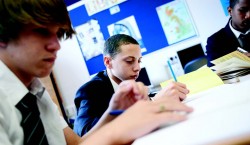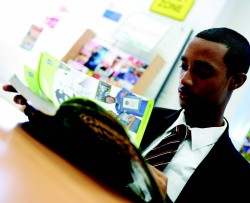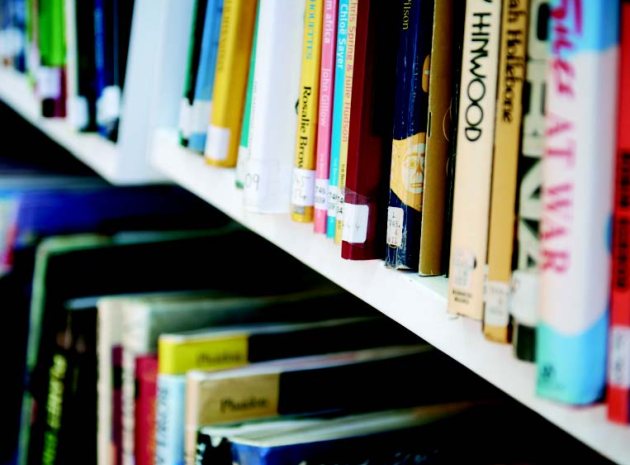
It’s a stark fact that Schools Library Services are facing a very uncertain future. Some 50 per cent of SLSs run by local authorities are undergoing a major review, and a recent survey carried out by the Chartered Institute of Library and Information Professionals (CILIP) looked at 92 local authorities in England and Wales and concluded that “if these results were replicated across England and Wales, 22 schools library services (one in five) could be facing the possibility of closure.” The study also revealed that 40 per cent of councils were cutting the cash for libraries this year compared to last.
“The threat to so many Schools Library Services is a serious concern,” admits school librarian and 2013 CILIP vice president, Barbara Band. “Across the country they contribute to children’s attainment and education by promoting reading, teaching essential research skills, improving literacy, lending books and resources, supporting teachers, arranging events and author visits.”
The CILIP survey was subsequently criticised by the Department for Education, which maintained it relied on a small-scale sample and failed to present the full picture.
But it was released at a time when there were already fears that many pupils were failing to read enough because of the powerful lure of the internet, games consoles and TV. Research published in 2012 found just three in ten school age children read every day in their own time compared with four in ten seven years ago.
Safe spaces
The growing concern over the future of the school library was highlighted in October 2012, when there was a mass lobby of Parliament. It prompted Jeff Norton, a London based writer-director and author, to consider the important role played by such facilities, reflections which have been published in January’s The Literary Platform. “It’s too easy to suggest that school libraries are a relic of the analogue world,” he observes. “Books are a small, but important part of the value that school libraries offer. But the safe space that libraries create, a place of study, reflection, and exploration, is [their] true gift.”
“The school library is a type of demilitarised zone in the war for daily schoolyard survival,” he continues. “It’s the one place where students who are serious about intellectual exploration can feel accepted and unashamed about wanting to excel. It’s the one place where loners, geeks, and misfits can escape to through fiction or fuel their interests with non-fiction. Why do we need to protect these people? Look at the world’s most valuable companies and take note of who’s in charge. It’s the kids who took shelter in the library, the geeks and nerds, who are re-programming our future. The books are important, of course. They are the ultimate tools in self-guided learning, but they are only part of the mix that makes school libraries an essential place to shelter and protect our most promising youth,” he adds.
Nick Cockayne, Director at Gresswell, the specialist school library supplier agrees. “We’ve been fitting out school libraries for over 75 years and have seen many changes,” he says. “We are constantly in touch with our customers to keep up to date with developments and the changing environment they work in - not only in the UK but across the globe. Multi-functionality is becoming key to the enhancement of any library or learning resource centre, whether in education establishments or for public use.”
Community spirit
One such example of multi-functionality can be found in the library at the state funded Marine Academy Plymouth (MAP) in Devon. It serves many purposes – from being the centre of reading in the academy, to providing a safe and secure environment where students can enjoy books, use technology for research, and develop independent learning as well as interact with adults and develop leadership skills through the mentoring of younger students. “The library is a social centre,” explains MAP’s librarian Chris Clews. “We see our role as modeling how, in the future, as adults and active members of our community, our students can develop ideas and experiment with engaging with global ideas.”
Indeed many schools are in an excellent position to respond to the challenges they face, given an imaginative and flexible approach. They can open their libraries to the wider community for instance, and make maximum use of affordable technology to improve the range of resources they are able to offer, as well as access to them.
As far back as 2010 a report titled ‘School Libraries in the UK: a worthwhile past, a difficult present – and a transformed future?’ commissioned by CILIP’s School Libraries Group concluded that 87 per cent of qualified librarians contributed to information literacy in their school with such activities as planning and conducting lessons in the library or classroom, often jointly with teachers. A growing number of library staff were actively engaging with ICT to make e-resources available and help develop e-learning platforms to support teaching and learning throughout the school, while some 25 per cent of qualified librarians were helping design and manage the school website and 59 per cent were contributing actively to the school VLE, learning platform or website.
“At MAP we use computer-based technologies to evaluate, monitor and track individual student progress and attainment in reading,” points out Chris Clews. “We regularly use video links of authors reading extracts from their novels to whole groups who then take an online quiz. We acknowledge student achievement through the plasma screens dotted around the site to show the whole community our champion readers and how they are excelling. We use the plasmas to communicate ideas, achievements and follow progress.”

The old and the new
Holloway School in Islington has a different approach. Whilst the school has benefited from a total makeover thanks to BSF funding, head teacher Bob Hamlyn believes the way forward lies in remembering the essentials. “Holloway School has taken an almost ‘back to basics’ approach to the library,” he explains. “For example, we unashamedly call it a library, not a learning resource centre (LRC) or similar. For us, the whole school is an LRC – and there’s enough technology throughout to facilitate independent research. Our library plays an important function within this concept of a whole-school LRC; namely to foster a love of books, particularly fiction. It’s modeled on how public libraries work: pupils can take out books for two weeks at time; they have a say on what titles we stock; and we celebrate the diverse nature of the books and interests we cater for. In the same way that public libraries support the local community, our school library also holds events, information and signposting that support the school community: for example Holocaust Memorial Day will be marked with a brief ceremony and time for reflection.”
Gresswell’s Nick Cockayne, meanwhile, thinks the future has room enough for both old and new. “Part of the role of the library has always been to help students make good decisions about what information to trust and what to discard,” he states. “The internet has changed the way in which we all find information and the big challenge for us is to help schools help their students to develop digital fluency, a blend of the old literacy skills with the new skills and knowledge they need to help them distinguish the good from the bad.”
“Take a look at how students like to read, study, find information or socialise,” he continues, “and these observations will help to understand what they value in a modern library space. The ubiquitous use of technology is no surprise and therefore the area needs to provide appropriate connection points for users, but just as important is the need to be able to work in groups or to find a place to study individually without interruption. Children’s personal circumstances may mean that such an environment may not always be available at home, and the library space can provide an area for these activities vital to studying. Whether reading takes place on tablet, e-reader, mobile device or book, the need to provide appropriate furniture that will create a relaxed and comfortable study environment should still be of importance within the school.”
MAP’s Chris Clews agrees. “We plan to use technologies such as Skype as a means of communication with authors and large groups of students across the globe,” he says. “Instead of an author visiting a school, our students will ‘visit’ them, see their context, understand their points of view and why they have evolved; they will talk with other cultures and be given a first hand insight into how those cultures operate and how that impacts upon the way in which different global communities respond to the same or similar challenges. The role of tablets and smart phones as a way of accessing, using and sharing information will be a major focus for us; gone are the days of confiscating students’ phones, we want to exploit them and the capacity of this generation to soak up knowledge and transform it, through their own ideas and imaginations, into technological advancement.”
These are undeniably challenging times for public libraries, with many of them being forced to reduce their opening hours, or even close completely, due to lack of funding. If schools can be as forward thinking as MAP and Holloway, then not only will their students benefit from a multifunctional library that supports and enhances their learning and is a place they genuinely want to be, but by extending the resources to pupils’ families and beyond, they could also find themselves more firmly embedded in the heart of the community than ever before, which is surely a consequence of which everyone would approve.
Case study: Wellington College – Future Vision
Wellington College is a co-educational independent school in Berkshire with over 1000 pupils. In the summer of 2012, its library was radically redeveloped to become a centre for innovative learning, reading, research, collaborative and independent study, embracing the latest technologies. The College’s library space includes a number of ‘pods’, which can accommodate varying numbers of students and enable flexible use of the space – from conversation classes to hosting the school’s intellectual and cultural societies, from individual study to collaborative revision using big screen computers and interactive white boards.
In addition, Wellington College is continuing to expand its e-book and online resource provision and work with its academic departments to promote these. When choosing an e-book platform the school was very keen to have multiple concurrent user access, which VLeBooks from Browns Books for Students delivers in addition to a dictionary, bookmarking and note sharing facilities. The library is equipped with iPads, each pre-loaded with the VLeBooks app, and pupils can also read VLeBooks via the e-Library.
The school has started running sessions with Year 9 to introduce VLeBooks. They are enthusiastic about the appearance of the interface and have rapidly started browsing the e-book catalogue and using the ‘suggest for purchase’ feature. When pupils come into the Library waving their mobile device and say “What can I read on this?” staff now have the answer. In 2013, Wellington College plans to expand the use of e-books in lessons and host group sessions demonstrating VleBooks, as well as training a group of e-book experts to explain to other pupils. Browns Books for Students, 01482 384660, bbfsnavigator.net, vlebooks.com
77% Of young people who read above the expected level for their age are school library users; compared with 35.9% of those who read below the expected level for their age (literacytrust.org.uk)











“Part of the role of the library has always been to help students make good decisions about what information to trust and what to discard…”